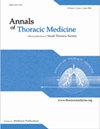随风而逝!大流行后支气管镜检查实践的变化:视角
IF 2.1
4区 医学
Q3 CARDIAC & CARDIOVASCULAR SYSTEMS
引用次数: 0
摘要
本文章由计算机程序翻译,如有差异,请以英文原文为准。


Gone with the wind! Changes in the practice of bronchoscopy post pandemic: A perspective.
From the first bronchoscopy in 1897, interventional pulmonologists (IP) have developed innovative technologies to improve diagnostic and therapeutic outcomes, revolutionizing the field of thoracic medicine.[2] Techniques and procedural preparation have also evolved to improve safety and minimize the risk of disease transmission. While the practice of interventional pulmonology continues to advance, the current COVID‐19 pandemic demands a conscientious, differential approach to any invasive or aerosol‐generating procedure. Studies have demonstrated that currently 6% of the total health‐care workforce has been infected by COVID‐19.[3] Emerging evidence suggests an airborne mode of transmission for COVID‐19, making the performance of bronchoscopy a high‐risk procedure.[4] In addition, the transmission of multidrug‐resistant microorganisms via bronchoscopy has necessitated the re‐defining of instrument decontamination, strict infection control policies, and prudent use of this revolutionary tool.[5] These critical challenges evoke core questions regarding the future of interventional pulmonology and the long‐lasting impact the pandemic may have on the practice of bronchoscopy.
求助全文
通过发布文献求助,成功后即可免费获取论文全文。
去求助
来源期刊

Annals of Thoracic Medicine
CARDIAC & CARDIOVASCULAR SYSTEMS-RESPIRATORY SYSTEM
CiteScore
4.10
自引率
4.30%
发文量
19
审稿时长
>12 weeks
期刊介绍:
The journal will cover studies related to multidisciplinary specialties of chest medicine, such as adult and pediatrics pulmonology, thoracic surgery, critical care medicine, respiratory care, transplantation, sleep medicine, related basic medical sciences, and more. The journal also features basic science, special reports, case reports, board review , and more. Editorials and communications to the editor that explore controversial issues and encourage further discussion by physicians dealing with chest medicine.
 求助内容:
求助内容: 应助结果提醒方式:
应助结果提醒方式:


